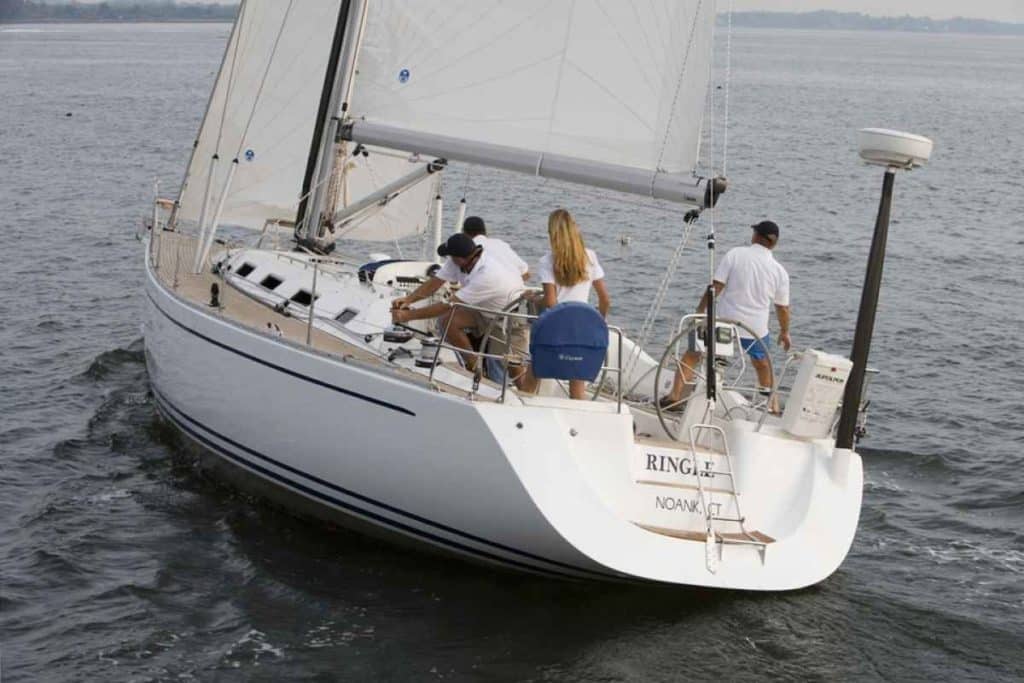
The Cruising World Boat of the Year judges didn’t have the opportunity to sail the Finngulf 46 in the stiff conditions typical of its Scandinavian home waters, but it still impressed us as it spun off knots that met or exceeded a very fluky zephyr’s speed and, according to the GPS, tacked in 95 to 100 degrees, including leeway.
A Volvo Penta drives the 46 easily at 7.5 to 8.5 knots. When sailing, the three-bladed folding prop minimizes drag.
Concluded BOTY judge Tom Linskey, “The boat’s really designed for performance sailing, like racing to Bermuda, where it’ll shine.” Other judges readily agreed.
Designer Karl-Johan Stråhlmann gave the Finngulf 46 a well-balanced, undistorted hull with a long waterline and narrow entry. The hull is no fat-reared wedge that gets squirrelly when the wind pipes up, but it does have firm aft sections that are adequately lifted to avoid dragging half the ocean behind it at speed. The Jefa steering system and high-lift balanced spade rudder make the helm responsive and smooth.
Other welcome hand-me-downs from the racing circuit include tackles that allow the crew to easily adjust the jib cars under load. The helmsman can drive comfortably from the high or the low side. With the traveler mounted on the cockpit sole and twin wheels, there’s an unfettered path from the companionway to the stern. In nice weather, the dodger can be folded down into a well-executed slot on the cabin top, enhancing the view from the cockpit. Crews can control the continuous mainsheet from either side. And Harken winches are generously sized and efficiently positioned, while most controls lead to the cockpit without overcrowding.
A full-length slotted toerail provides copious options for snatchblocks and other attachments. And inboard chainplates keep the side-decks open.
Linskey also suggested that the highly powered Finngulf “could be a real handful for Mom and Pop.” Indeed, the sail area on the fractional Seldén rig is generous, but experienced voyagers will appreciate the canvas during the many times they’ll encounter light airs. Reductions in average passage times have come at least as much from boosting light-air performance as from speed in stiff winds, when even modest-displacement boats are restrained by hull speed. The sail plan features a slightly overlapping jib that tacks easily. A genny, a cruising chute, and storm canvas would nicely round out a simple sail inventory.
The BOTY judges appreciated the Finngulf’s features that maximize soundness, safety, and practicality of maintenance. Its modern styling may belie its conservative construction. Bulkheads are all glassed to the hull rather than simply cemented into liner slots. There’s no hull liner; instead, a heavy grid glassed into the bottom stiffens the hull and carries the rigging and keel loads. The hull/deck joint is not only glued but also through-bolted, an increasingly rare feature that I applaud in a cruising boat. Access to the engine as well as steering and other critical gear is excellent via easily removed panels. Seacocks are few and easily found. One can remove the overhead liner with little effort to access deck gear.
On deck, a life raft can live in its dedicated locker at the stern, where it’s protected and best positioned for deployment. A bridgedeck protects the cabin from downflooding, and jackline-attachment points and emergency tools in a locker close to the cockpit are provided. Although the cabin-top handrails are well placed, I’d like to see them extended forward of the mast. The Finngulf’s cabin top is wide enough to hold an 8-foot dinghy or deflated RIB. Fenders, spare sails, and other cruising kit can be stored in the large deck locker aft of the anchor well without soaking up cabin space. I’d like to see gaskets on the locker top, but it’s well sealed from the rest of the boat and can be pumped out separately.
The interior layout combines traditional practicality with airy Scandinavian styling. Satin varnished teak contrasts with the bright upholstery and overhead liner. Large-radius corners will reduce injuries should crews get bounced about. Cushions on the double berths in the aft cabins are split and have attachment points ready to fit lee cloths. The dinette settee will make a good sea berth, too. Two-inch fiddles keep countertop contents in place. Generous storage space exists in the cabins and galley, though vent holes in locker doors would help retard mildew. The galley features deep double sinks and good task lighting, but I think the two-burner stove is a tad small for most long-term cruisers. The aft-facing nav station offers a table large enough to spread a chart, a feature starting to become rare on today’s electronics-oriented boats; there’s also a dimmer for the light and a plug for a laptop. With little to brace against, though, the navigator may have a hard time staying seated when the boat is heeled on port tack. It would be good to see handrails on the deckhead, too.
Finngulfs are built on a semicustom basis, including deck and interior layouts, so owners can get the Finngulf 46 pretty much the way they want it. One could, with adequate customization and fitting out, travel far on this boat. If the 46 gets your performance-cruising blood up, you can be sure of a fast ride.
Steve Callahan, a longtime CW contributor, was a 2008 Boat of the Year judge.








